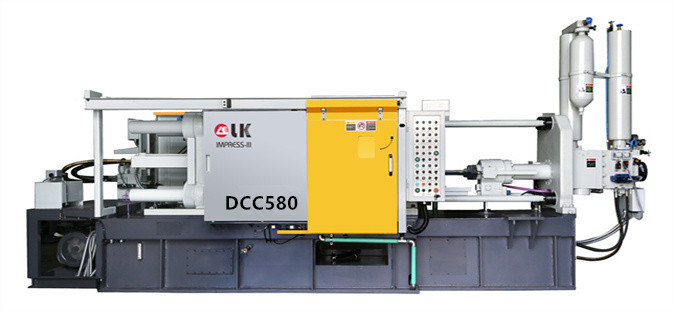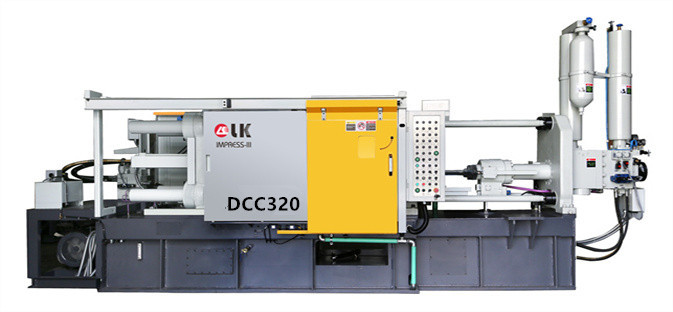What is a Mold in Machinery?
LK Die Casting Machine / 2024-07-15 11:39:57
Mold is a very important tool in industrial production and is called the "mother of industry".
It can process raw materials into products of various shapes and specifications through specific shapes and structures. Molds are widely used, covering various
fields such as automobile manufacturing, electronic products, household appliances, and building materials.
This article will introduce in detail what molds are in machinery, including its definition, types, manufacturing process, applications, and its importance in the
industry.

Definition of mold
A mold is a tool used for molding processing. Through their specific shape and structure, raw materials (such as metal, plastic, glass, ceramic, etc.) are processed
into parts or products of specific shapes and specifications.
Molds play a key role in the manufacturing process, enabling mass production and ensuring product quality and consistency.
Types of molds
Molds can be divided into the following categories according to their uses and processing methods:
1. Injection molds
Injection molds are mainly used for the production of plastic products.
Plastic raw materials are injected into the mold cavity by heating and pressurizing, and the required plastic products are formed after cooling.
Common injection mold products include toys, home appliance housings, automotive interior parts, etc.
2. Stamping Dies
Stamping dies are used for the processing of metal sheets.
The stamping machine applies pressure to the metal sheets to deform them in the mold cavity to form the required metal parts. Common stamping die products include
automobile body parts, home appliance housings, etc.
3. Die-casting Dies
Die-casting is used for the molding of molten metal. The molten metal is injected into the mold cavity under high pressure and the required metal parts are
formed after cooling.
Common die-casting die products include automobile engine parts, mobile phone housings, etc.
4. Extrusion Dies
Extrusion Dies are used for the continuous production of long-strip products.
The raw materials are extruded out of the mold cavity at high temperatures to form the required shape. Common extrusion die products include plastic pipes, cable
sheaths, etc.
5. Blow Molding Dies
Blow molding molds are used for the production of hollow plastic products.
The heated plastic pipe is placed in the mold and expanded into the shape of the mold by blowing. Common blow molding mold products include plastic bottles,
plastic barrels, etc.
6. Other Types of Molds
In addition to the above common mold types, there are also rotary molds, foaming molds, injection molds, etc., which are widely used in various industries.
Mold manufacturing process
The mold manufacturing process is complex and precise, and usually includes the following steps:
1. Demand analysis
Before mold manufacturing, it is necessary to conduct a demand analysis to understand the customer's specific requirements for the mold, including the shape, size, material, and performance of the mold.
2. Mold design
Based on the results of demand analysis, use computer-aided design (CAD) software to design the mold and generate detailed design drawings and technical documents.
3. Material preparation
Select suitable mold materials according to design requirements and perform material pretreatment, such as cleaning, descaling, and cutting.
4. Rough machining
Use CNC machining centers, EDM machines, wire-cutting machines, and other equipment for rough machining to remove excess materials and form the basic shape of the mold.
5. Heat treatment
Heat treatment of the mold to improve the hardness, strength, and wear resistance of the material. Common heat treatment processes include quenching, tempering and
carburizing.
6. Finishing
Use grinders, polishing machines, and other equipment for finishing to improve the dimensional accuracy and surface quality of the mold.
7. Mold assembly
Assemble the various parts of the mold to ensure that the parts fit tightly and are positioned accurately.
8. Mold debugging
Test the mold, check the working condition of the mold, and adjust various parameters to ensure that the mold can work normally.
9. Mold acceptance
According to the acceptance criteria, conduct a comprehensive inspection of the mold to ensure that the various performance indicators of the mold meet the design
requirements.
10. Mold delivery
Package and transport the mold, and provide customer training and after-sales service to ensure that customers can use and maintain the mold correctly.
Application of molds
Molds are widely used in modern industry, covering almost all manufacturing industries. The following are the applications of molds in some major industries:
1. Automobile manufacturing
In automobile manufacturing, molds are mainly used to manufacture automobile bodies, engine parts, interior parts, etc. For example, car doors, engine cylinders,
dashboards, etc. all need to be formed and processed by molds.
2. Electronic products
In electronic product manufacturing, molds are used to produce shells and components of various electronic products.
For example, mobile phone shells, computer cases, TV shells, etc. all need to be produced by injection molds or die-casting molds.
3. Household appliances
In the manufacture of household appliances, molds are used to produce the shells and parts of various household appliances.
For example, washing machine shells, refrigerator liners, air conditioner shells, etc. all need to be molded by molds.
8. Building materials
In the manufacture of building materials, molds are used to produce various building components and decorative materials. For example, precast concrete parts, ceramic tiles, floor tiles, etc. all need to be molded by molds.
5. Medical devices
In the manufacture of medical devices, molds are used to produce various medical devices and instruments.
For example, syringes, medicine bottles, medical device shells, etc. all need to be molded by molds.
8. Packaging materials
In the manufacture of packaging materials, molds are used to produce various packaging containers and packaging materials.
For example, plastic bottles, plastic barrels, packaging boxes, etc. all need to be produced by blow molding molds or injection molds.
9. The Importance of Molds in Industry
Molds have an important position and role in modern industry, which is mainly reflected in the following aspects:
1. Improve production efficiency
Molds can achieve mass production and improve production efficiency. Through mold molding, a large number of products can be produced at one time, reducing the
production time and cost of a single product.
2. Ensure product quality
Molds can ensure the quality and consistency of products. Through mold molding, the dimensional accuracy and surface quality of products can be effectively
controlled to ensure the consistency of each product.
3. Reduce production costs
Molds can reduce production costs. Although the manufacturing cost of molds is high, mass production through molds can significantly reduce the production cost of
a single product and improve the economic benefits of the enterprise.
4. Realize the processing of complex shapes
Molds can realize the processing of complex shapes.
Through mold molding, complex shapes, and precision parts that are difficult to achieve with traditional processing methods can be manufactured to meet the diverse
needs of modern industry.
5. Promote technological progress
The continuous advancement of mold manufacturing technology has promoted the development of the entire manufacturing industry.
Advanced mold manufacturing technology not only improves production efficiency and product quality but also promotes the application and development of new
materials, new processes, and new equipment.

Development trend of mold manufacturing
With the continuous advancement of science and technology, mold manufacturing technology is also developing continuously. In the future, mold manufacturing will
develop in the following directions:
1. Intelligence
Intelligent manufacturing is one of the development directions of mold manufacturing in the future.
By introducing intelligent technologies such as artificial intelligence, the Internet of Things and big data analysis, the mold manufacturing process will be more
intelligent and automated, improving production efficiency and product quality.
2. High precision
With the continuous improvement of industrial products' requirements for precision, molding will develop in the direction of high precision.
By adopting advanced processing equipment and processes, such as high-precision CNC machining centers and ultra-precision grinders, the processing accuracy of
molds will continue to improve.
3. Multifunctionality
Future molds will be more multifunctional, and one mold for multiple uses will become a trend.
One mold can realize the production of a variety of different products, improve the utilization rate of molds, and reduce the production costs of enterprises.
4. Green Manufacturing
Environmental protection and energy saving are important directions for future mold manufacturing.
By adopting green materials and processes, we can reduce energy consumption and environmental pollution in the mold manufacturing process and achieve green
manufacturing.
5. Customization
With the diversification and personalization of market demand, mold manufacturing will develop in the direction of customization.
Through digital and intelligent technology, we can achieve rapid design and manufacturing of molds to meet the personalized needs of customers.
Summary
Molds are an indispensable and important tool in modern industrial production. Through their specific shapes and structures, raw materials are processed into
products of various shapes and specifications.
For more info, you can refer to: https://www.youtube.com/shorts/JLX410QV_kw
Contact LK Egypt to learn more info about the die-casting machine
LKAGENT OFFICE DCM
Address: Industry Zone, South of Port Said Kebly, Egypt
https://www.zazdiecasting.com/
Phone: +86 13598704163
Mobile: +20 101 304 3317 +20 150 181 8310
Email: jack@zazmae.com ahmedmahmoud@zazmae.com
#die cast tooling
#trivalent chromate
#rapid prototype casting
#a360 aluminum
#aluminum caster
#aluminum prototype
#ideal 55 slider parts
#density of aluminum kg/mm3
#magnesium sheet metal
#parts of a metal gate
#subcontracting of screw machining for the luxury sector
#wall aluminum
#die casting tooling
#tooling for die casting
#density of aluminium in kg mm3
#clear chromate
#es casting metals
#gating material
#prototype aluminum
#sigma castings
#subcontracting of screw-machining for household appliances
#we squeeze to please machine
#aluminium gravity die casting
#aluminum part
#aluminum rapid prototyping
#nickel casting
#plunger tip for die casting machine
#rapid prototyping aluminium
OTHER CONTENT
-

2024-09-19 14:16:15 LK Cold Chamber Die Casting Machine DCC900 Locking Force: 9000KN Die Height: 400-1000mm Space Between Tie Bars: 930x930mm Shot Weight: 13.5Kg Casting Area Max:2250c㎡
More -

2024-09-19 14:11:06 LK Cold Chamber Die Casting Machine DCC280 Locking Force: 2800KN Die Height: 250-650mm Space Between Tie Bars: 560x560mm Shot Weight: 2.9Kg Casting Area Max:700c㎡
More -

2024-09-19 10:23:07 LK Cold Chamber Die Casting Machine DCC580 Locking Force: 5000KN Die Heigh: 350-850mm Space Between Tie Bars: 760x760mm Shot Weight: 6.9Kg Casting Area Max:1250c㎡
More -

2024-09-19 10:11:20 LK Cold Chamber Die Casting Machine DCC400 Locking Force: 4000KN Die Height: 300-700mm Space Between Tie Bars: 669x669mm Shot Weight: 4.7Kg Casting Area Max:1000c㎡
More

